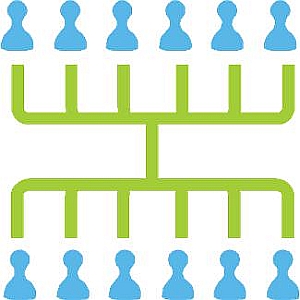- Project risk management plan: Definition
- Project risk management plan: Purpose
- Project risk management plan: Software
- Project risk management plan: Content
- Methodology and Approaches
- Roles and Responsibilities
- Budgeting
- Time frames
- Categorized risks
- Probability and impact
- Tracking
- Project risk management plan: Approaches
- Avoidance approach: All the conditions that cause a risk are to be eliminated before the risk occurs.
- Acceptance approach: A risk’s existence is acknowledged by the project management team but no preemptive action to remove or mitigate the risk is taken.
- Mitigation approach: A set of preemptive actions are to be applied in order to mitigate a risk’s occurrence, or to reduce the impact of the risk occurred.
- Deflection approach: An identified risk or its part is to be transferred to another organization.
A risk management plan (rarely known as a risk mitigation plan) for a project is a formal document that describes how to deal with specific risks and what risk managing actions can be taken in order to mitigate or remove threats to the project activities and outcomes. The project risk management plan gives members of the project management team a sense of the risk managing actions they can take to identify, analyze and respond to threats around and within the project. The risk mitigation plan is a subsidiary plan in the hierarchy of the project management plan. The given project risk management plan definition is common and relevant to most kinds of project, including IT projects and constriction projects.
The plan is a part of common risk management information system that exists during the whole life-cycle of the project. The risk management information system combines all the driving forces that cause the project management team to do some actions for treating project risks.
The project risk managing plan is intended for guiding the project management team through all the whole process of managing project risks which includes such major steps as Risk Identifying, Risk Analyzing, Risk Responding and Risk Controlling. The risk mitigation plan purpose is in providing the team with a clear understanding of the necessary actions to be taken in order to protect the project from hidden and identified threats and to utilize existing opportunities for improving project performance.
Usually a project management software example is used to develop and manage a risk management plan outline. Such software allows using project risk templates, risk checklists and risk forms to define a series of tasks required to carry out the process of managing project risks. A project management software example features collaboration functionality, sharing capability and centralized data storing capability that allows multiple users to access a central database stored on a server over LAN or Internet. In a given risk managing plan outline, the project manager uses such software to specify main risk managing activities and assigns roles and responsibilities to the people involved. A project management software example is sometimes called “risk management plan software“. Examples of such software are Microsoft Project, VIP Task Manager.
The project risk mitigation plan content includes a list of specific actions that the project management team will take in order to deal with threats in an expected manner, as well as a list of roles and responsibilities that the team acquires in order to carry out a chosen risk management methodology and risk mitigation strategy. Ideally, the risk mitigation plan content is presented as an evolutionary document that captures all the information on the outcomes of the risk strategies and risk treatment action plans for future reference. Often it has a tabular view, and by means of risk management plan software, spreadsheets can be added to the content. The content includes descriptions of identified risks and allows associating the risks with specific work packages within the work breakdown structure. It describes a risk management methodology and gives recommendations regarding writing risk event statements and risk response statements, as well as risk response procedures. In general, there are the following paragraphs in the plan:
There are four basic risk managing approaches acknowledged by the Project Management Institute:
The basic risk managing approaches are common and can be applied to a variety of projects, including IT projects and construction projects. Whatever approaches are applied, a risk response plan is to be developed. The risk response plan is a document that incorporates reference to the risk management terms and definitions and what they mean and determines which risk response procedures are to be conducted.











